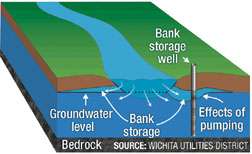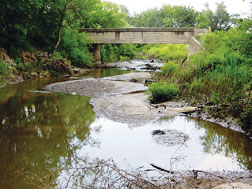| + click to enlarge |
 |
|
Aquifer replenishment system relies on intakes, bank recharge wells to capture water.
|
The High Plains Aquifer is one of the world’s greatest sources of fresh water, sprawling beneath 175,000 sq miles in parts of eight states from South Dakota to Texas and holding 2,980 million acre-ft of water, roughly the volume of Lake Huron. But that resource went largely untapped until the mid-twentieth century when the development of high-power, high-capacity pumps allowed farmers and municipalities to extract large quantities of water, transforming the plains into the world’s feed basket.
Success comes with a price and by 1980 water officials noticed dramatic drops in underground water levels, with areas of southwest Kansas, New Mexico, Texas and Oklahoma recording decreases between 60 ft and more than 100 ft, according to the U.S. Geological Survey. In 2000, USGS reports that 17 billion gallons of water per day was pulled for irrigation and 315 mgd was pulled for public drinking water. In 1999, USGS began a six-year High Plains Regional Groundwater Study to fully investigate water quality throughout the aquifer.
|
Wichita, Kan., water officials started to research ways to reduce their groundwater needs in 1980s. For more than 40 years, the city water utility had drawn up to 65 mgd of clean drinking water from the Equus Beds, a shallow aquifer that drops to 250 ft below the surface of the city’s wellfield. Officials preferred high-quality underground reserves over water from the nearby Cheney Reservoir, which has higher turbidity levels. By the 1970s and 1980s, agricultural irrigation pumping and the city’s growing needs dramatically lowered aquifer levels, says Utilities Director David Warren. If aquifer levels declined further, officials worried that saline water from the nearby Arkansas River and a plume of brine from old oil operations nearby could be drawn to the city’s source and raise chloride levels above drinking water standards of 250 mg/l by 2050.
The city’s first idea was to propose construction of a 125-mile pipeline to bring water in from a reservoir in northeast Kansas. But political opposition of interbasin water transfer was strong, leading to passage of the state Water Transfer Act that set strict conditions for such action. Warren en-listed Kansas City-based Burns & McDonnel to perform a system-wide water needs study through 2050. The result was an integrated water-supply plan, released in 1993.
Its lynchpin is a $300-million project that relies on greater use of water from the reservoir and other surface waters and construction of a 100-mgd aquifer storage and replenishment system. The first step was taken in 1993 when the city reversed the ratio of reservoir water to groundwater to 60:40. That change has already resulted in an 8-ft increase in groundwater levels at the city’s wellfield because of reduced pumping, says Warren.
“Now, we use the reservoir for 80% of supply and use groundwater for 20%,” he says.
Limits
To do that, Wichita officials had to convince state regulators. Their aquifer storage and replenishment project was the first ever proposed in Kansas and the state lacked permitting regulations. In August 2005, after two years of negotiations with the state that also resulted in ancillary standards governing livestock lagoons and housing development in the affected area, the city garnered its permit for the $100-million first stage, a 10-mgd project to capture surplus wet-weather surface and underground flow from the Little Arkansas River. The river is partially fed by discharge from the Equus Beds but the first-phase capacity was reduced to 7 mgd when further studies found that their connection was not as robust as first thought.
To ensure downstream agricultural water rights, the city is not permitted to draw water unless the river’s 20-cfs base flow is exceeded. During irrigation season, the river must be running at least at 65 cfs, accounting for base flow and downstream water rights. In an average year, Blaine says the completed system would work about 120 days.
For the first phase, water is drawn off through surface intakes and bank-storage diversion wells. Bank storage wells are placed about 50 ft from the river and are designed to capture excess flow that moves into the river bank in wet weather, says David Stous, Burns & McDonnel chief water supply hydrologist. Flow is then sent to a water treatment plant before being piped about six miles to recharge wells and basins in the city’s well fields.
  Wichita Water Utilities Excess flow from Little Arkansas river (top) is sent to recharge basin (above.)
|
Blaine says the inconsistent nature of the recharge system has him rethinking treatment technology. “We’re looking for technology that is flexible enough to handle start-and-stop operations,” he says. The first-phase treatment plant, built by a joint venture of the Wichita office of CDM and CAS Construction Inc., Topeka, uses a ballasted flocculation process. Microsand particles are added to the flocculation process, causing the floc to sink quickly. The system provides a 14-minute retention time, compared to four to six hours in a conventional plant. As the system is built out, other technologies such as reverse-osmosis may be considered should costs drop, says Blaine.
The system is already showing results. A five-year demonstration project recharged one billion gallons to the Equus Beds. The-first phase project was completed in summer 2006 but could not operate until this past spring because of dry weather. Blaine says the system has stored 300 million gallons so far this year.
There’s plenty of room to grow. The district estimates the dewatered component of the Equus Beds has capacity to hold 65 billion gallons, a volume equal to pre-1940 levels. “We’d need four to five years of really wet weather to make that up,” says Blaine.
The project’s benefits are numerous. The more water pumped into the aquifer, the more that drains into the river, increasing the volume of low flows, Blaine notes. Officials already have noticed a bump in the hydraulic barrier needed to impair encroachment from the oilfield brine plume. And higher groundwater levels will reduce the pumping costs of irrigators. “It’s a win-win situation for everyone,” says Warren.
But aquifer recharge is the key ingredient for long-term needs. The city’s system now supplies an average of 60 million gallons per day, with a capacity of 160 mgd, says Jerry Blaine, city superintendent for production and pumping. By 2050, that is expected to jump to 112 mgd and 210 mgd. Related Links:
Related Links: 
Post a comment to this article
Report Abusive Comment